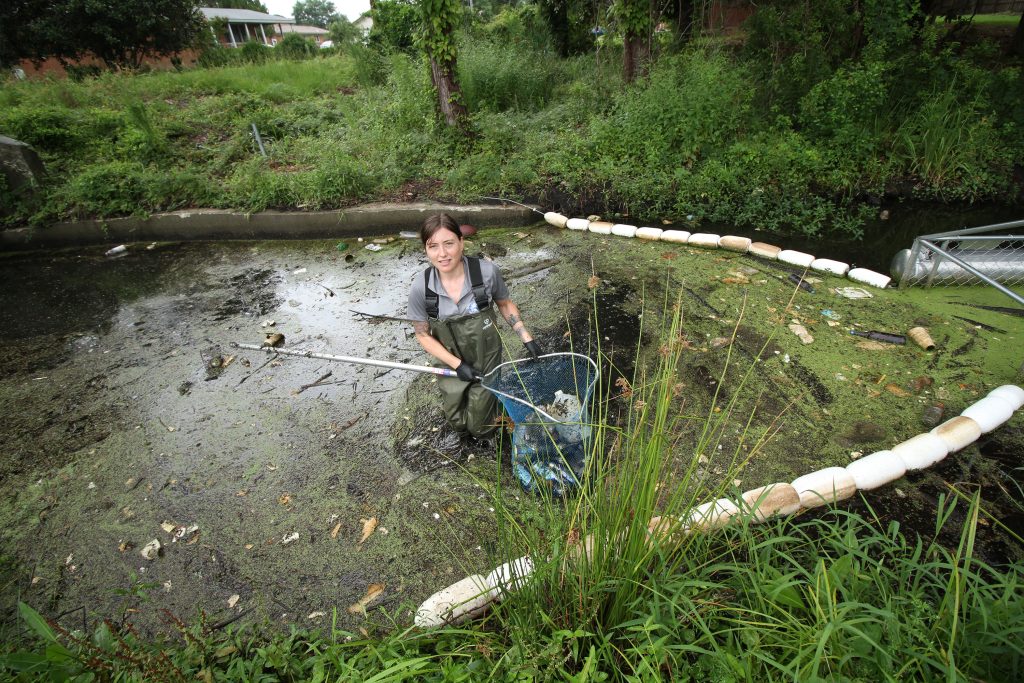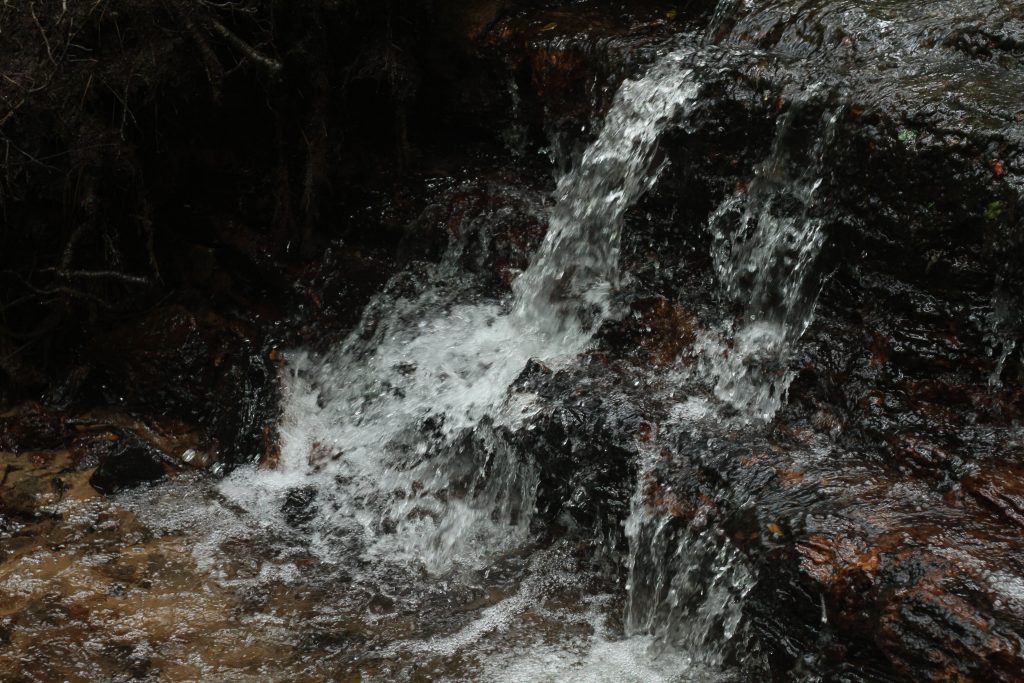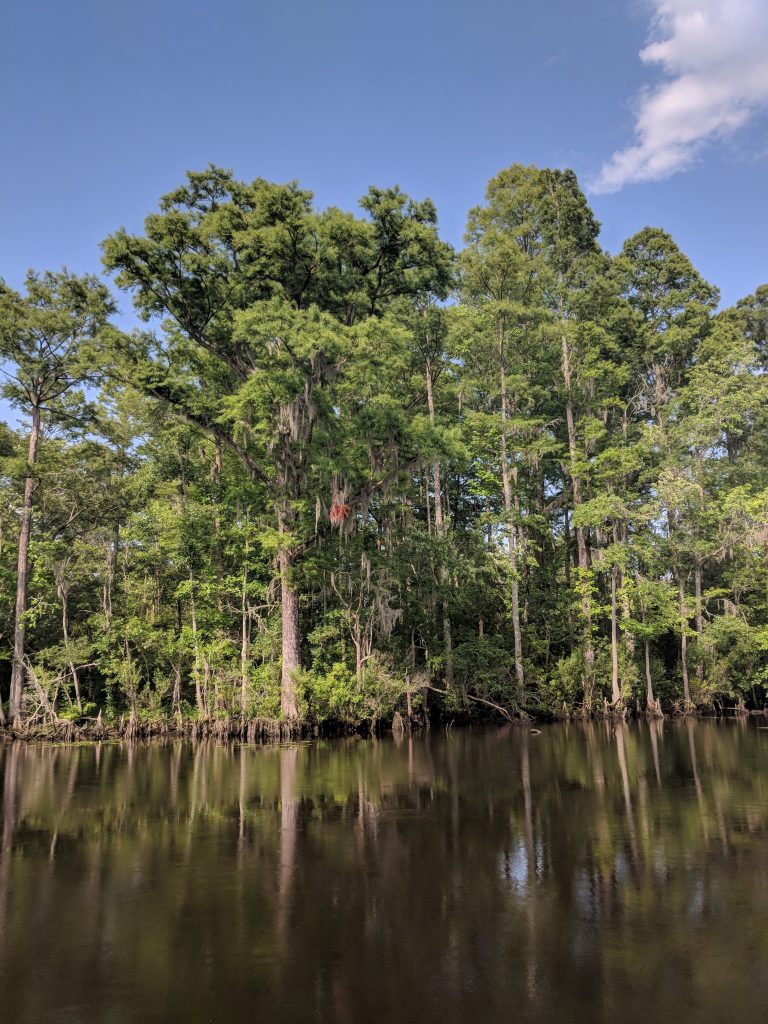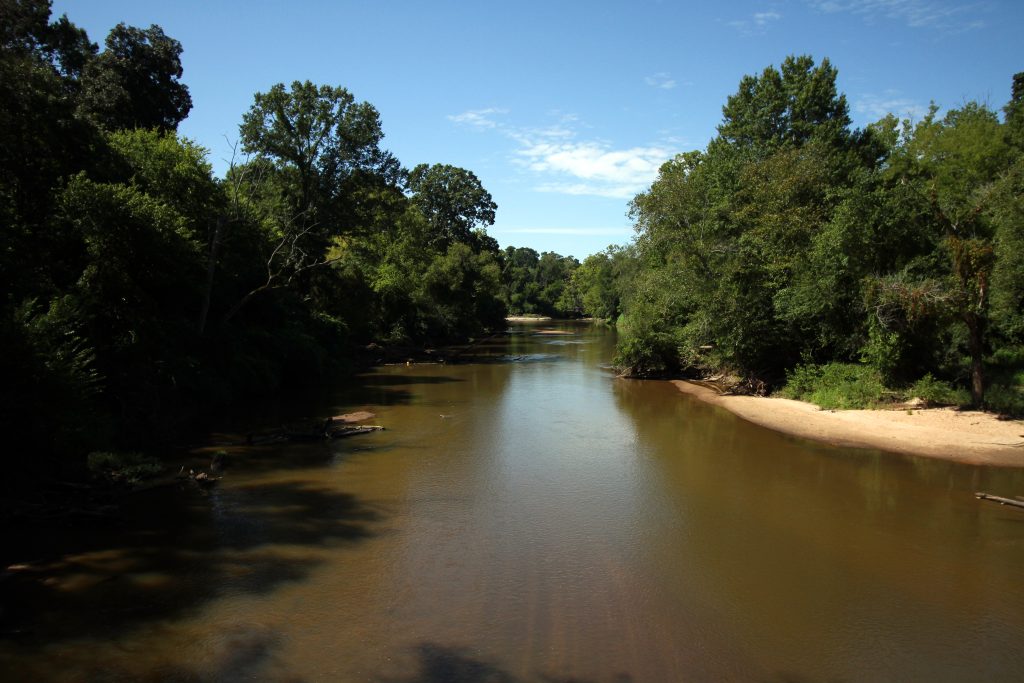Our History: Full Story
VOICE FOR THE RIVER
It’s a clear, crisp November day in eastern North Carolina, and high above the lowlands surrounding the Trent and Neuse rivers, Samantha Krop is on a mission.
Through the window of a twin-propeller Cessna, Krop points out a massive, covered lagoon — part of a biogas-harnessing industrial swine facility — that ruptured and spilled millions of gallons of foam made from decomposing waste, dead hogs and expired deli meats over the land and into Nahunta Swamp in May of 2022.
“This facility has a clear history of illegally discharging waste, and DEQ knew it. They failed to take meaningful action to prevent a major pollution event from happening, and failed to adequately notify the public,” Krop says. “This is people’s drinking water; it’s the water they swim in; it’s the water they fish from — and the agency responsible for protecting it isn’t doing its job.”

Krop is the Neuse Riverkeeper, and she — like her counterpart on the Tar-Pamlico, Katey Zimmerman — regularly takes to the waterways and skies to surveil potential sources of water pollution. They’re the latest crew of Riverkeepers, carrying on a fight for clean water that’s been waged for decades. That battle began when two communities, separated by many miles of the Coastal Plain, took the health of the rivers in their own hands, forming grassroots organizations serving as watchdogs for the waterways. Today, they are Sound Rivers, a merger of two of the oldest environmental nonprofits in North Carolina, now celebrating more than four decades of being the voice for our rivers.
SOUND RIVERS

Forty years ago, a fundamental change had taken place in the Neuse and Tar-Pamlico rivers. Fish and crab, so abundant in previous decades, had declined. Forests of sea grass had disappeared, seemingly overnight.
“I grew up here, and I was born in ’48. I lived on the river, so I spent my childhood in the river. It was a blissfully ignorant time, an innocent time. We had no environmental concerns,” said Linda Boyer, who grew up at Summer Haven, just east of Washington. “Then, gradually, the area became more developed. We had a lot more houses on the river. We had a lot more serious, big farming. We had industry come in. Gradually the river became degraded because of all those factors, you know, slowly trickling down into the river. People started noticing fewer fish, fewer crabs; we started getting crab diseases. The future of the river — people started getting concerned about what would happen if there was no regulation.”
The change was not going unnoticed further south, on the Neuse.
“Back then, we swam; we didn’t get infections. We fished, we floundered, just really enjoyed it and didn’t think particularly of what the water might contain,” said Grace Evans, a lifelong sailor who first sailed the Neuse in 1960, then made the area her permanent home in 1972. “The first thing that we noticed back then was that there was a lot of trash, whether it was beer cans or just whatever people had thrown overboard — washing machines, toilets, hunters throwing deer carcasses in the creek. There was a lot of litter.”
But as massive fish kills began to occur regularly, clogging beaches and waterways with the dead and dying, a movement was started.
THE EARLY DAYS: ON THE PAMLICO
“It’s interesting to see the evolution of the organization, how we got from the kitchen table to the organization we have now. At the start, there was no staff, and I don’t know when or where we decided to call ourselves a board — that was a little presumptive on our part — but we just did what we needed to do to get things done,” laughed Dr. Ernie Larkin, one of the founders of Pamlico-Tar River Foundation.
PTRF, indeed, made its start around the kitchen table in the Summer Haven home of Ross and Linda Boyer.

“What were those early meetings like? Very long,” Boyer laughed. “We had two babies, and I would put the babies to bed, and I would sit in on the meetings. There was a lot to talk about, a lot to learn, a lot to try to come to grips with.”
Under the leadership of Dick Leach and Billy Jackson, seated at that table were long-time Summer Haven residents and other river-lovers determined to put a stop to the river’s decline. The first order of business was to sway Beaufort County commissioners from approving a plan to allow Texasgulf Chemicals Company to mine the riverbed at its Aurora site — and they did.
Throughout the remaining decade, Pamlico-Tar River Foundation led public resistance to many proposals that would have damaged the river, wetlands and more, and worked with Texasgulf, the state and other environmental agencies to resolve another ongoing issue at the Aurora facility: nutrient pollution. Nutrient may seem like an innocuous term, but when excessive nutrients are dumped into waterways, they feed algae, which leads to massive algal blooms and de-oxygenated water that kills fish in equally massive quantities.
“Some of it was just direct negotiation with (Texasgulf). I remember just going down there and talking to those folks and hearing what they had to say. And they did something; they changed their process with wastewater to recycle it,” Larkin said. “They were dealing with a lot of phosphates, a lot of nutrients, that they were putting in the water, and they knew that and did something about it.”
1989 was a turning point, however. It was the year the Tar-Pamlico River Basin was declared Nutrient Sensitive Waters by the Division of Environmental Management — those responsible for nutrient overloads needed to stop. It was also the year the Division of Marine Fisheries declared the river “commercially dead,” so decimated was the commercial fishing and crabbing industry.
On the Neuse, things were no better.
THE EARLY DAYS: ON THE NEUSE
“As a kid, I always wanted to be fisherman, but my mother and father talked me out of it,” said Rick Dove.
Dove got his chance, however, after earning a law degree, then getting a draft notice for Vietnam that resulted in a 20-plus-year career in the U.S. Marine Corps.
“I came here in 1975; the Marine Corps brought me here. When I walked out the gate for the last time, I traded my spit-shined shoes and put on the dirtiest clothes I could find and became a commercial fisherman,” Dove said. “Things were great until about 1990.”
That’s when the catch from the Neuse became riddled with sores; Dove and his son, Todd, who fished with him, had them too.
“I wouldn’t eat the fish, so I decided couldn’t sell them either,” Dove said.

Dove hung up his dirtiest clothes, went back to practicing law and found a new calling when he was hired as the Neuse Riverkeeper at the behest of Evans and other members of the Neuse River Foundation. At that point, NRF had been successful in its bid for a statewide ban on cleaning products containing phosphorous, which entered the waterways through sewage treatment plants, much to the detriment of aquatic life.
When Dove came aboard, he put his law degree to use again, this time going after those polluting the river, directly.
“We sued wastewater treatment plants and hog farms. Our docket had 20 cases on it, all the time. We were in court a good bit of the time, but most of our cases were settled out of court,” Dove said.
The Neuse River Foundation grew from 70 members to more than 2,000. The Neuse River had gotten a bad reputation, devastating both tourism and the housing market, and disparate interests banded together to do something about it. Hundreds of volunteers patrolled and sampled the water at points from the lower Neuse up to Raleigh, and local pilots volunteered their planes to get a bird’s-eye view of pollution sources.
A designated force of creek-keepers took an active role in tracking salinity, turbidity and oxygen levels in tributaries.
“It was a very active time in the ’90s. We got pretty good results with all the screaming and yelling we were doing about the health of the river,” Dove said.
Merging of Minds
Decades of advances in water quality were offset by steps backward, even as much-loved fundraisers to fund the work of the organizations drew large crowds of river-lovers — the PTRF Oyster Roast on the grounds of the Civic Center in Washington and NRF’s Taste of Coastal Carolina in New Bern. Then, in 2015, the voice for the river became louder when the Pamlico-Tar River Foundation and Neuse River Foundation merged to become a powerful advocate for protection of the watersheds covering nearly a quarter of the state of North Carolina.
“Sound Rivers has become a respected environmental voice,” Boyer said. “It’s always had integrity, and it’s always had one goal, which is to preserve the health of the river.”
Results included injunctions against industrial hog farms and EPA payouts to clean up rivers, as well as the creation of pollution-reducing rules by the state that were put in place for the Neuse River Basin in 1997. New rules for the Tar-Pamlico followed in 2000.
Heather Deck, Sound Rivers’ executive director, said that’s due to the long-time dedication of members, board members, volunteers and staff — too many to count.
“Over the past 40 years, we’ve been able to expand our efforts and influence to support many more communities up and down both rivers,” Deck said. “But the organization has remained true to its mission and effort to give the people a voice for the river and their communities. Everyone has a right to have an impactful voice in determining the protection and use of their communities’ natural resources — including our water resources — and no person should bear the disproportionate impact of pollution.”
But 40 years after two communities set the stage for grassroots environmental advocacy, gathering around kitchen tables and in borrowed offices, the work is far from over.
“People are just kind of shortsighted when it comes to the importance of a healthy environment, and it’s been so for a long time,” Larkin said.
Deep budgets cuts to North Carolina’s Department of Environmental Quality over the years has meant watching over the waterways and doing much of the work necessary to keep rivers swimmable, fishable and drinkable has fallen to organizations such as Sound Rivers.
“If it’s going to get fixed, it’s going to be fixed by the waterkeepers. There’s nobody else out there doing the work. The rivers are screaming because they’re out of balance with nutrients, and when nature goes out of balance, it comes back with things like fish kills,” Dove said, referring to the fish kills on the Neuse in recent years that have brought public concern a level reminiscent of the past. “I’d like to see us get back to what we used to do. We need to get tough again. Somehow, we need to get the message out to the public forum. We don’t have to be all negative, but we certainly have to speak for the river in ways that are honest and strong. You can’t compromise the river to support pollution. You just can’t.”
